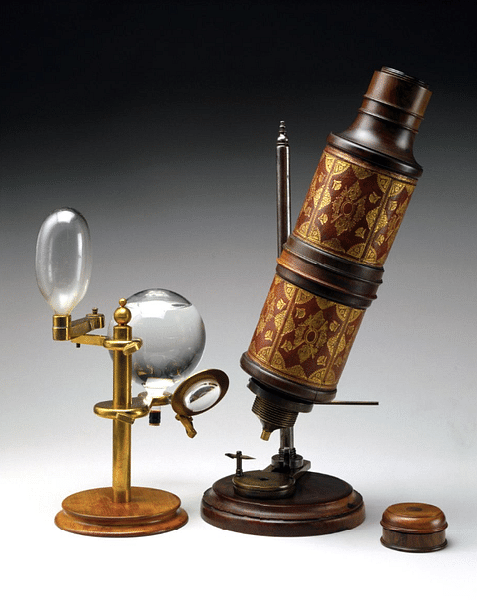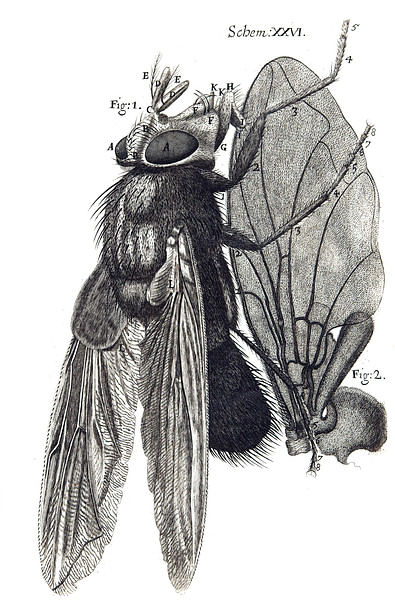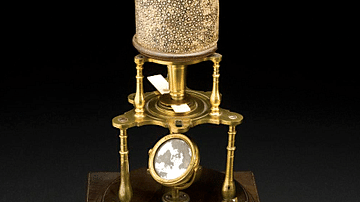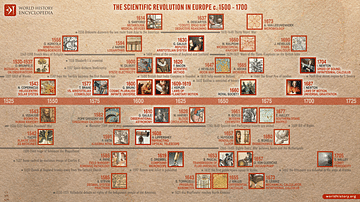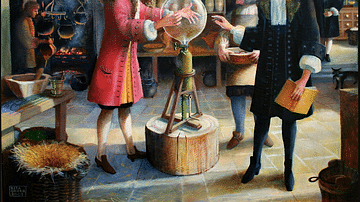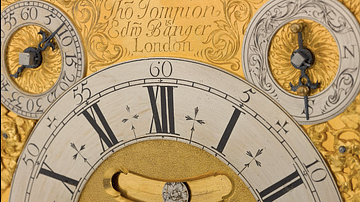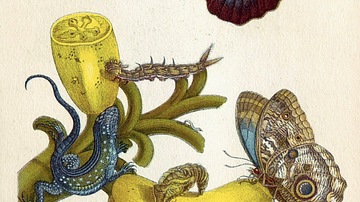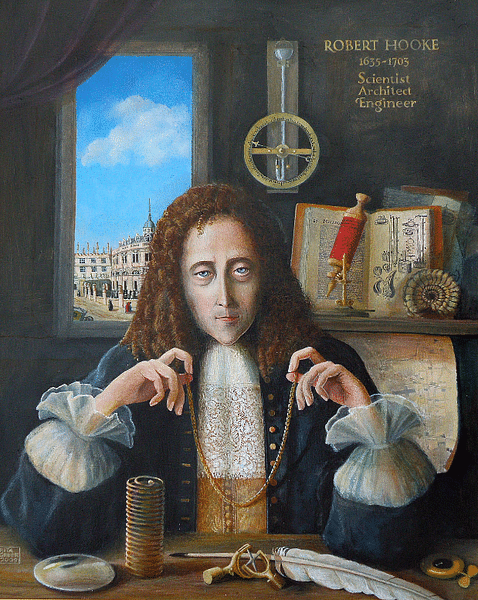
Robert Hooke (1635-1703) was an English scientist, architect, and natural philosopher who became a key figure in the Scientific Revolution. Hooke conducted his scientific experiments outside the auspices of universities, and he was a great believer in the importance of technological innovations in instrumentation, pioneering countless improvements in the fields of navigation, optics, and clockmaking, amongst many others.
Early Life
On 18 July 1635, Robert Hooke was born into a poor family, and because of snobbery and prejudice, this fact would be an obstacle throughout his scientific career. Hooke managed to display enough academic talent to enter the University of Oxford, and there he impressed such noted anatomists as Robert Boyle (1627-1691) and Thomas Willis (1621-1675). Hooke was appointed lab assistant to both Boyle and Willis, but it was with the former that he forged a special working relationship, even inventing a sophisticated air pump for Boyle's experiments in chemistry in 1659.
It was not science that supported Hooke's research, though, but his lucrative work as an architect and surveyor in London. The income from these activities, particularly in the massive rebuilding that followed the Great Fire of London in 1666 gave Hooke the financial freedom to pursue his scientific endeavours. In 1675, Hooke was involved in the selection process for a site for a new observatory at Greenwich, and he was also an integral part of the design stage along with Christopher Wren (1632-1723). Hooke ultimately supervised the building's long period of construction. Hooke and Wren had already closely collaborated on the design of the new St. Paul's Cathedral, the surveyor giving invaluable aid on the problem of how to build its large dome. Hooke continued his involvement in London's dramatic new skyline by designing, again with Wren, the 65-metre (202 ft) high hollow column that commemorated the terrible Great Fire. Ever the practical scientist, Hooke conducted experiments in gravity and air pressure from the high ceiling of the old St. Pauls' and even tried to fit a giant telescope within the Great Fire monument but, alas, without success.
Hooke & the Royal Society
Hooke, perhaps because of his humble background, was a notable omission from those fellows who founded the Royal Society in 1662. The Royal Society of London for Improving Natural Knowledge was formed as a public body to promote research. Hooke, thanks to the intervention of his old associate Boyle, did at least manage to creep into the back door of the society and gain an appointment as Curator of Experiments. The position also gave him sole custody of the keys to the society's library, and Hooke frequently abused this privilege by removing learned volumes and precious manuscripts for study in the comfort of his home. Like a squirrel that cannot remember where his nuts are buried, Hooke seems to have found great difficulty in returning these works to their rightful place and was frequently censured for his negligence. In 1663, the society finally consented to making Hooke a full fellow. Hooke was given paid lodgings at Gresham College in central London where, two years later, he was made Professor of Geometry (a position he held for the next 38 years). Hooke was clawing his way up the barbed ladder of academia even if he bore the added weight of not being an accomplished mathematician, which was then (and possibly still is) the expectation of any natural philosopher, that is, a great mind who can explain and predict the world around us. Still, Hooke remained undaunted, and between 1677 and 1682, he rose again to serve as secretary of the Royal Society.
At the Royal Society, Hooke was instrumental in its experimentation activity, and he pioneered improvements in all sorts of equipment and instruments, such as barometers, clocks, pumps, telescopes, and microscopes. As the historian L. Jardine notes: "A man of resolutely practical bent, his response to any scientific problem was to invent a piece of equipment to resolve it" (44). Hooke had close ties with instrument manufacturers and practical inventor-engineers like Thomas Newcomen (1664-1729), who pioneered variations of the steam engine in the British Industrial Revolution. Hooke made sure that his own various machines had identical gears, and this fact permitted mass production of them, an innovation that many would copy thereafter. Hooke developed the iris diaphragm in telescopes, which limits the light entering the device so that light only enters through the aperture that can then be regulated by the user (like a modern camera shutter). He developed a deep sea sounder and created the universal joint, that is, a joint capable of connecting two inclined shafts – this type of connection still bears his name. Hooke attempted to make a chronometer that could withstand the sharp movements of a sailing vessel at sea so that longitude could be accurately measured, but, like many others before him, in this endeavour, he failed. He did help mariners in other ways, developing a new type of reflecting quadrant for navigation and a self-levelling compass.
All of these technical developments illustrate the difference between Hooke, a keen mechanic and engineer, and such noted contemporaries as his mentor Boyle and Isaac Newton (1642-1727), who both added theology to their largely theoretical studies. Still, Hooke clearly had friends in the Church, for he received a medical degree in 1691, an award masterminded by no less a figure than the Archbishop of Canterbury. The degree was perhaps in recognition of Hooke's contributions to medicine and his public experiments in dissection.
Hooke may have been its "experimental impresario and practical wizard" (Jardine, 63), but he was not without his enemies within the Royal Society. He famously fell foul of the hypersensitive Newton after Hooke accused his fellow member of plagiarising his work on optics and on the inverse-square law of gravity (both charges had no real grounds). Newton withdrew from the society and refused to accept its presidency until Hooke had died. As the historian W. E. Burns puts it: "[For] Hooke and Newton, two of the most gifted grudge-holders of the scientific revolution, the feud was long and ugly" (140). It was perhaps true that Hooke had given Newton the grain of an idea when he noted that the discovery by Johannes Kepler (1571-1630) that planets moved in elliptical orbits might be due to a force we now call gravity, but Newton refused to acknowledge any help from anyone. The two men drew their own personal followers into the dispute, and so for years, British science and mathematics were fractured into two groups: the Newtonites and the Hookeists, a fault line which wasted much energy and delayed new discoveries.
The Microscope & Micrographia
Hooke's first major publication was an enduring work which captured the imagination of its readers then and now with its striking illustrations of what could be seen through a microscope: Micrographia. Published in 1665, Micrographia was dedicated to Charles II of England (r. 1660-1685) and was "the seventeenth-century equivalent to a coffee-table book" (Jardine, 42). The illustrations, made by a professional engraver using extensive drawings made by Hooke himself, caused a sensation, showing the intricate details of insects like fruit flies, lice, and fleas, as well as many plant seeds in high magnification. The intricate and remarkably faithful drawings astounded people who had never imagined that such flora and fauna were so complex, an idea that for many confirmed their belief in a divine Creator as who else could have created such wonders? Hooke also covered more mundane objects which under a microscope appeared completely different from how they were seen with the naked eye. He showed, for example, that the point of a metal needle was actually a ragged end of metal. The reason Hooke could show this new world better than anyone else was because of his technical tweaks to the microscope. He obtained clear images thanks to his scotoscope, that is, "a light-condensing brine-filled globe between his lamp light-source and his specimen" which "narrowly focussed the lamp's intensified beams by means of a convex lens" (Jardine, 44).
Micrographia described Hooke's technical innovations for the microscope, which was then still a notoriously difficult instrument to use even for experts. Micrographia begins with advice on how to best use the instrument and where to buy a good one. The book was innovative in terms of language, too, since it contains the first use of the word 'cell' (in this case, used to refer to cork cells seen under a microscope). Hooke was, unsurprisingly, in the top five microscopists in Europe, but he was not always correct in his theories, notably his endorsement of the idea that tiny insects were capable of spontaneous reproduction. One consequence of Micrographia was a boom in microscope sales. After reading a copy, Samuel Pepys (1633-1703), the famous diarist, was inspired to spend £5 and 10 shillings (equal to nearly 3 months' wages for a labourer at the time) on a microscope for his study. Unfortunately, like almost everyone else, Pepys had great difficulty seeing anything at all clearly through his microscope. Medical practitioners were also disappointed with the microscope, and so it languished behind other instruments like the telescope in terms of impact during the Scientific Revolution.
Theoretical Advances
Hooke published a collection of his lectures in mechanics in his Cutlerian Lectures. The scientist was well-known for his hands-on approach to improving instruments and machines, but he was also responsible for several theoretical innovations, such as his idea that the planet Jupiter turned on its own axis. He believed Earth had shifted its axes. Hooke collected fossils and supported the idea that they were actual evidence of lifeforms of long ago and not some freak of nature that merely looked like once-living organisms. Keen on springs – so important to so many machines of the time, particularly clocks – Hooke formulated a way to measure the pressure on a spring and its resultant elasticity, a formula which became known as Hooke's Law.
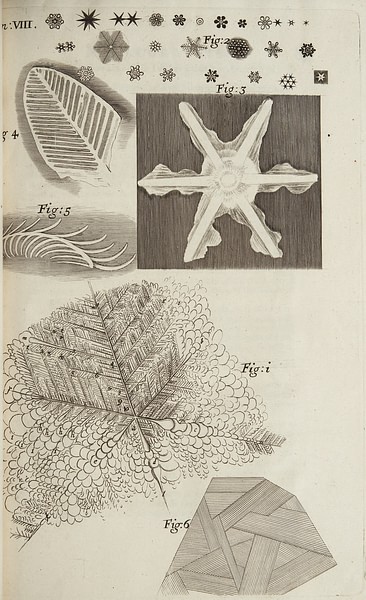
Like many thinkers of his time – when primacy was an issue of paramount importance – Hooke rigorously defended his work, and so he fought many legal battles against plagiarists or those who claimed to have first invented something he had already designed. Christiaan Huygens (1629-1695) and his claim he invented the balance spring for watches is just one example of someone Hooke pursued relentlessly. As a consequence of this defensive attitude, Hooke fell out with several key contemporaries who had investigated and extended his original ideas without his consent, and he wasted much time and money that could well have been better spent on furthering the knowledge of all humanity.
Death & Legacy
It is remarkable that Hooke lived for as long as he did. He was a keen consumer of chocolate, recording his rate of consumption of that delicacy in his daily diary. Much worse than this, he was constantly ingesting bizarre substances to scientifically record their effects on his body. Consuming in trial periods, amongst many other oddities, such harmful substances as opium, wine mixed with lead, steel or iron, powdered wormwood, poisonous flora, and even ammonium chloride, Hooke seems to have regarded himself as the guinea pig par excellence for fashionable medical cures and treatments. Sometimes these substances improved Hooke's energy and clarity of thought, but more often than not, he suffered many pains and physical inconveniences. Robert Hooke died on 3 March 1703; he was 67 years of age. He had never married and had no children. Hooke received a memorial plaque in Westminster Abbey, not quite the grand monument bestowed upon Newton.
Hooke's final contribution to scientific literature was his Posthumous Works, which, rather ironically, opened with a dedication to Newton. Hooke's legacy was seriously diminished when Newton took over the presidency of the Royal Society in 1703 and then proceeded to systematically remove as many references to his rival as he could over the next 24 years. Nevertheless, Hooke remains "one of the most inventive and versatile thinkers in the scientific revolution" (Burns, 139), a crucial figure who combined practical experiments with vast theoretical knowledge garnered from his own extensive library (borrowed or otherwise). Perhaps most importantly of all, Hooke championed the view that accurate instruments were as essential to the armoury of a scientist as a pencil is to an architect or a brush to an artist. Science had moved on from being a purely contemplative discipline to one of hands-on testing and experimentation, what Hooke himself had described as a "reformation in philosophy" (Wootton, 34).
